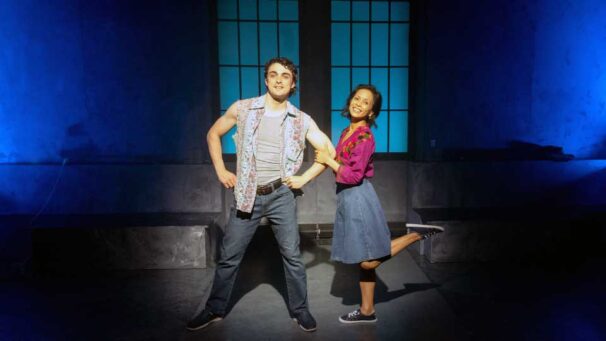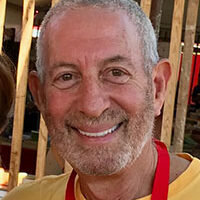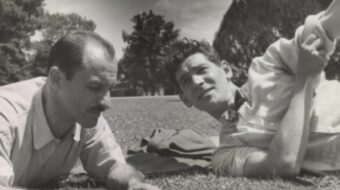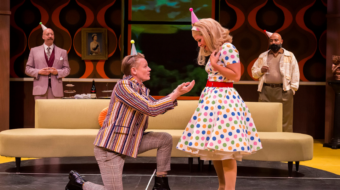
LOS ANGELES—Following closely on the heels of California Story (Part 1 of their Califas Trilogy), Part 2, Roger Q. Mason’s Hide and Hide, world premiered on May 16 at the Skylight Theatre Company in the Los Feliz area. Part 3, Juana Maria, will receive a staged reading at the LACC Caminito Theater on May 25 and June 1.
Starring the very amazing talents of Amielynn Abellera as Constanza De La Fe, a Filipina immigrant who believes, during the Ferdinand Marcos years, that she will achieve happiness and success in the U.S., and Ben Larson as Billy “Sweet Boy” Adams, a white Texan rent boy who has run away from a Christian sex conversion camp, the two-person Hide and Hide is a nonstop noir thriller of a play lasting only about 90 minutes (no intermission) and encompassing worlds of life and experience in the seedy underbelly of Los Angeles in 1980. Complicated as the drama is, a Rubik’s Cube of construction with each actor embodying several roles, and even overlapping each other playing another main character who looms in each of their lives, director Jessica Hanna has liberated the difficult script from the printed page to make it shine brilliantly.
Mason dissects the American Dream as it impacts a young woman eager to find a suitable partner for marriage and eventual citizenship, and a young man finding that his best route to survival lies in finding a well-paying trick for the night. Their lives collide while searching for the freedom dreamed up on movie screens, billboards, and our minds, an illusory mirage to be sure, but very real compared to the oppressive situations they are leaving.
The title of Mason’s play derives from an expression in the Philippines suggesting that if you have something to hide, you likely have other things you need to hide as well.

Among the characters the two actors summon up are Ricky, a gay Filipino who emigrated to the U.S. in 1956 to become a lawyer in America specializing in “selling a dream”—helping newcomers grapple with the immigration system, using every loophole, both legal and otherwise, to obtain fake documents and permanent status in the U.S.; and Constanza’s Aunt Tita, her family’s first American stakeholder who also has made a profession of finding ways to normalize life for new immigrants. After all, “immigration is workforce recruitment.” Constanza rejects all her ideas, including prostituting herself. Tita had almost arranged a marriage to an older man in a wheelchair—“You marry and divorce yourself into a bank account”—but Constanza holds out for the beautiful Billy, whom she meets at a disco club.
“Los Angeles is a sanctuary city, one that our residents and visitors will depend upon more deeply now that our federal freedoms are at risk,” says playwright Roger Q. Mason. “It is a place where dreams are made real, but it is also a site of perilous ambition. The same drive that fuels Angelenos to innovate can also be destructive if we let it be. Hide and Hide is a cry for the power of communal empathy in a society that pushes us to run towards our individual goals at the expense of the collective journey. This play finds two characters grappling in 1980 with questions about place, power, and ambition that have eternally vexed sojourners to the golden shores of California.”
What impresses a theatergoer is that neither of these two characters is any paragon of innocence. Each is a deeply flawed individual (aversion to spoilers prevents divulging more) and hardly worthy of adulation. Yet what one can admire is the pluck and courage it takes to try and overcome a wretched past and recreate oneself for a possibly happier future. The playwright stops well short of resolving their issues by the end of the play. “America is a drug deal and we’re just junkies.” But in the meantime, he has succeeded in winning our empathy for these hard-hit people with few options left.
“Peace—that’s all I wanted so I wouldn’t have to be running all the time,” Constanza grumbles.
Also making the play a must on this season’s calendar is Mason’s deployment of language itself, perhaps comparable on today’s stage to the poetry of Tennessee Williams’s best plays:
“Hide and Hide represents a style of writing that I love dearly: poetic expressionism. A fusion of spoken word, image-ism, and jazz poetry, this dramaturgical vocabulary is where I feel most at home in the theatre. It allows me to sing from the page, to take you as an audience to those deep recesses of your subconscious world that don’t often catch light, except when we dream.”
Director Jessica Hanna also has words to conduct us on this excursion into the home-seekers’ underworld:
“We all have places, times, and people we carry with us that have been key in our journey. And we go back to them again and again, to give ourselves comfort and guidance and to find who we are in the current moment. It can take great strength to move forward in life, especially when the powers that run this country don’t want folks outside of white hetero normative life to succeed. It takes great energy and resilience to survive outside of that system. This is a story of people in the United States who have to find their own path and support each other in who they are and who they could be. It is a story of the past that is still very true today.”
Performances are scheduled on Thurs., Fri., Sat. and Sun., and one Mon. (June 2) through June 29 at Skylight Theatre, 1816 1/2 N. Vermont Ave., Los Angeles 90027. Tickets are available for advance purchase here. More information about the other plays in the Califas Trilogy can be found here.










